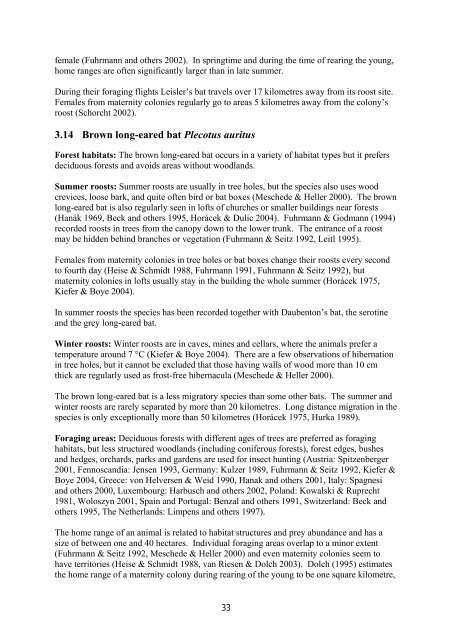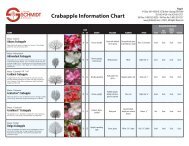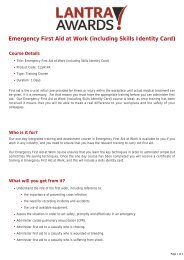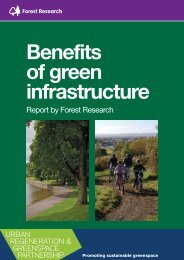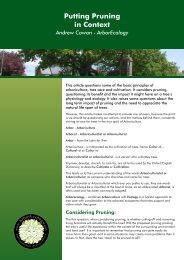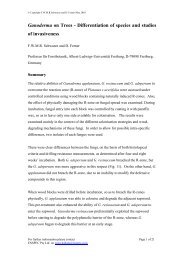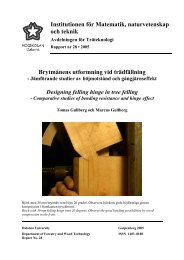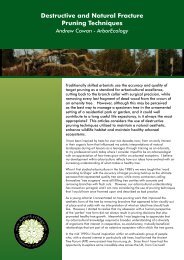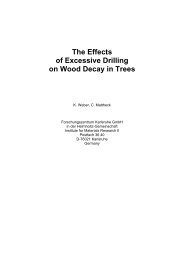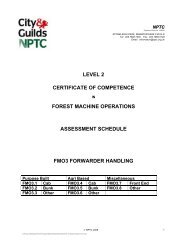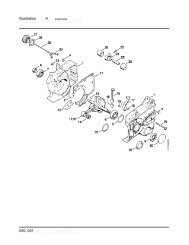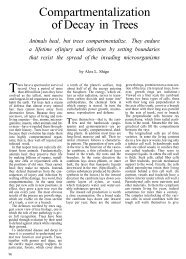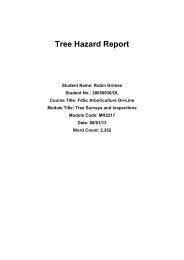Germany changed roosts nearly every day. All of the roosts were in woodlands at distancesof 50-1,700 metres from each other (Fuhrmann and others 2002).In eastern Germany a maternity colony of about 40 females used a roost site network of 50roosts during one year of investigation. The bats moved within this network frequently(Meschede & Heller 2000, Schorcht 1998).Leisler’s bat has been recorded to share summer roosts with Daubenton’s bat, Bechstein’sbat, common pipistrelle, Nathusius’ pipistrelle and noctule (Meschede & Heller 2000).Winter roosts: Hibernating animals were found in Switzerland in tree holes, in Germanythere are observations from bat boxes (Meschede & Heller 2000, Bogdanowicz & Ruprecht2004).Leisler’s bat is considered a long distance migrant. Winter roosts of a population resident inGermany during summer are at least partly at a very large distance (400-1,100 kilometres,e.g. Spain). Through ringing experiments, seasonal migrations were proved between Russiaand the Turkish Black Sea coast, Poland and Slovakia and between Germany and Spain,France, Austria and Switzerland (Roer 1989, Ohlendorf and others 2001, Schorcht & Boye2004).Other roosts: Besides the roosts used during the day females have special roosts <strong>for</strong> rests orsocial contact, where they sometimes stay <strong>for</strong> several hours at night together with conspecificfemales from other colonies. They leave these roosts be<strong>for</strong>e dawn, returning to their dayroosts (Fuhrmann and others 2002, Schorcht 2002). During mating time males occupyspecial mating roosts, which are situated ideally on top of a hill and have free flight access.The territorial males patrol within a radius of about 300 metres around the mating roost andstart swarming if they can attract a female (Ohlendorf & Ohlendorf 1998).Foraging areas: There is little in<strong>for</strong>mation about <strong>for</strong>aging areas in the various parts of thedistribution area in Europe (Bogdanowicz & Ruprecht 2004, Miric & Paunovic 1997,Austria: Spitzenberger 2001, Greece: von Helversen & Weid 1990, Hanak and others 2001,Luxembourg: Harbusch and others 2002, Poland: Kowalski & Ruprecht 1981, Woloszyn2001, Russia: Grigoryev & Vassilyev 1999, Slovenia: Krystufek 1974, Spain and Portugal:Benzal and others 1991, Switzerland: Stutz & Zingg 1995, The Netherlands: Limpens &Kapteyn 1991). Following observations made in Germany, it seems the bats choose their<strong>for</strong>aging areas because of prey abundance and free flight space, not because of habitatstructures (Meschede & Heller 2000). In eastern Germany a telemetric study found thatLeisler’s bat <strong>for</strong>ages on the one hand in large woodland areas, having no preference <strong>for</strong>certain <strong>for</strong>est types or stands, and on the other hand in diverse open landscapes and overwater. They did not avoid human settlements (Schorcht 2002). In southwest Germany most<strong>for</strong>aging activity is recorded at lakes and rivers near <strong>for</strong>ests, above <strong>for</strong>est clearings and along<strong>for</strong>est roads or rides. Each <strong>for</strong>aging area is used only <strong>for</strong> limited time of the year (Harbuschand others 2002).In Germany home ranges were estimated to be at least 1.5 square kilometres in size <strong>for</strong> anadvertising male and 6 square kilometres <strong>for</strong> a female. The <strong>for</strong>aging areas visited during theinvestigation were all in <strong>for</strong>ests in the case of the male, but <strong>for</strong> about 50% of time wereoutside the <strong>for</strong>est at a river valley, in orchards and along street-lit roads in the case of the32
female (Fuhrmann and others 2002). In springtime and during the time of rearing the young,home ranges are often significantly larger than in late summer.During their <strong>for</strong>aging flights Leisler’s bat travels over 17 kilometres away from its roost site.Females from maternity colonies regularly go to areas 5 kilometres away from the colony’sroost (Schorcht 2002).3.14 Brown long-eared bat Plecotus auritusForest habitats: The brown long-eared bat occurs in a variety of habitat types but it prefersdeciduous <strong>for</strong>ests and avoids areas without woodlands.Summer roosts: Summer roosts are usually in tree holes, but the species also uses woodcrevices, loose bark, and quite often bird or bat boxes (Meschede & Heller 2000). The brownlong-eared bat is also regularly seen in lofts of churches or smaller buildings near <strong>for</strong>ests(Hanák 1969, Beck and others 1995, Horácek & Dulic 2004). Fuhrmann & Godmann (1994)recorded roosts in trees from the canopy down to the lower trunk. The entrance of a roostmay be hidden behind branches or vegetation (Fuhrmann & Seitz 1992, Leitl 1995).Females from maternity colonies in tree holes or bat boxes change their roosts every secondto fourth day (Heise & Schmidt 1988, Fuhrmann 1991, Fuhrmann & Seitz 1992), butmaternity colonies in lofts usually stay in the building the whole summer (Horácek 1975,Kiefer & Boye 2004).In summer roosts the species has been recorded together with Daubenton’s bat, the serotineand the grey long-eared bat.Winter roosts: Winter roosts are in caves, mines and cellars, where the animals prefer atemperature around 7 °C (Kiefer & Boye 2004). There are a few observations of hibernationin tree holes, but it cannot be excluded that those having walls of wood more than 10 cmthick are regularly used as frost-free hibernacula (Meschede & Heller 2000).The brown long-eared bat is a less migratory species than some other bats. The summer andwinter roosts are rarely separated by more than 20 kilometres. Long distance migration in thespecies is only exceptionally more than 50 kilometres (Horácek 1975, Hurka 1989).Foraging areas: Deciduous <strong>for</strong>ests with different ages of trees are preferred as <strong>for</strong>aginghabitats, but less structured woodlands (including coniferous <strong>for</strong>ests), <strong>for</strong>est edges, bushesand hedges, orchards, parks and gardens are used <strong>for</strong> insect hunting (Austria: Spitzenberger2001, Fennoscandia: Jensen 1993, Germany: Kulzer 1989, Fuhrmann & Seitz 1992, Kiefer &Boye 2004, Greece: von Helversen & Weid 1990, Hanak and others 2001, Italy: Spagnesiand others 2000, Luxembourg: Harbusch and others 2002, Poland: Kowalski & Ruprecht1981, Woloszyn 2001, Spain and Portugal: Benzal and others 1991, Switzerland: Beck andothers 1995, The Netherlands: Limpens and others 1997).The home range of an animal is related to habitat structures and prey abundance and has asize of between one and 40 hectares. Individual <strong>for</strong>aging areas overlap to a minor extent(Fuhrmann & Seitz 1992, Meschede & Heller 2000) and even maternity colonies seem tohave territories (Heise & Schmidt 1988, van Riesen & Dolch 2003). Dolch (1995) estimatesthe home range of a maternity colony during rearing of the young to be one square kilometre,33
- Page 3: English Nature Research ReportsNumb
- Page 7 and 8: ContentsPreamble1. Legal aspects...
- Page 9 and 10: 1. Legal aspectsThere are three int
- Page 11 and 12: to the Agreement decided that the c
- Page 13 and 14: Country European Community EUROBATS
- Page 15 and 16: types in Europe where many of the e
- Page 17 and 18: • the European Commission initiat
- Page 19 and 20: Foraging areas: Central European sp
- Page 21 and 22: Other roosts: In foraging areas and
- Page 23 and 24: Brandt’s bat travels up to 250 ki
- Page 25 and 26: others 2004). Maternity colonies al
- Page 27 and 28: 1995, The Netherlands: Limpens and
- Page 29 and 30: from a maternity colony covered a t
- Page 31: hibernaculum is the Levensau Bridge
- Page 35 and 36: Foraging areas: In Central Europe f
- Page 37 and 38: Table 2 Importance of tree holes fo
- Page 39 and 40: sites it was found that the possibi
- Page 41 and 42: advancing age of a tree its potenti
- Page 43 and 44: floor up to the canopy and beyond c
- Page 45 and 46: Table 6 Overview of the most freque
- Page 47 and 48: 6.2 2nd step: Active search for roo
- Page 49 and 50: This first approach to a woodland b
- Page 51 and 52: number of tree-dwelling birds in pr
- Page 53 and 54: Types of boxes used by batsThere ar
- Page 55 and 56: oxes exposed to the sun. As an exam
- Page 57 and 58: Con: Bats use bat boxes selectively
- Page 59 and 60: 9. ReferencesABULADZE, A., BUXNIKAS
- Page 61 and 62: BEKKER, J.P. 1990. Ervaringen met v
- Page 63 and 64: BRAUN, M., & HÄUSSLER, U. 2003c. K
- Page 65 and 66: Ökologie und Verbreitung von Arten
- Page 67 and 68: (Germany). In: PRIEDE, I. G. & SWIF
- Page 69 and 70: (Nyctalus leisleri) sowie zur Besie
- Page 71 and 72: HEISE, G. 1985. Zu Vorkommen, Phän
- Page 73 and 74: JONES, G. 1990. Prey selection by t
- Page 75 and 76: (Chiroptera: Vespertilionidae). - P
- Page 77 and 78: Ökologie und Verbreitung von Arten
- Page 79 and 80: PÉREZ, J. L. & IBÁÑEZ, C. 1991.
- Page 81 and 82: ROTTMANN, R., BOYE, P. & MEINIG, H.
- Page 83 and 84:
SCHORCHT, W., and others. 2002. Zur
- Page 85 and 86:
STUTZ, H.-P. B. & HAFFNER, M. 1989.
- Page 87 and 88:
WAGNER, M., KERTH, G. & KÖNIG, B.
- Page 89:
10. AuthorsDr. Peter Boye became fa


